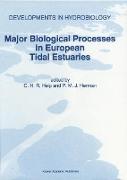- Start
- Major Biological Processes in European Tidal Estuaries
Major Biological Processes in European Tidal Estuaries
Angebote / Angebote:
Table 1. State variables modeled in MOSES. State variable Units Estuaries are characterized by a strong diversity in car bon sources. This is because of the existence of an 3 Fast-decay detritus g- intertidal habitat, the supply of nutrients and organic 3 Slow-decay detritus g- material from the river and from the sea and the input of 3 gCm- Freshwater diatoms matter from human origin. If turbidity remains limited, 3 Freshwater flagellates g- estuaries can also support a high primary production 3 Brackish and marine diatoms g- as nutrients are abundant. Nevertheless, estuaries are 3 Cm- Brackish and marine flagellates usually heterotrophic ecosystems (Billen et aI. , 1991, 3 gCm- Micro-zooplankton Smith & Hollibaugh, 1993) where respiratory process 3 Brackish meso-zooplankton gCm- 3 es exceed in situ production. Marine meso-zooplankton gCm- 2 3 gCm- The Westerschelde estuary (260 km in SAWES, Hyperbenthos 3 gSim- Detrital silicate 1991) drains about 21580 square kilometres ofland in 3 gSim- Dissolved silicate one of the most densely populated and highly industri 3 gNm- Nitrate and nitrite alised regions of Europe (Wollast, 1988). This estuary 3 gNm- Ammonia is unusual due to the high degree of eutrophication 3 gOm- Oxygen which results from the discharge of untreated wastes 3 gCl m- Chlorides (Heip, 1988) and due to the high residence time of the 3 gm- Suspended matter water masses (Soetaert & Herman, 1995a).
Folgt in ca. 5 Arbeitstagen
